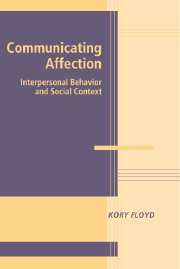Book contents
- Frontmatter
- Contents
- List of Tables
- List of Figures
- Foreword
- 1 AN INTRODUCTION TO AFFECTIONATE COMMUNICATION
- 2 THINKING ABOUT AFFECTION: THE THEORIES
- 3 ENCODING AFFECTIONATE MESSAGES
- 4 DECODING AND RESPONDING TO AFFECTIONATE EXPRESSIONS
- 5 BENEFITS OF EXPRESSING AND RECEIVING AFFECTION
- 6 RISKS ASSOCIATED WITH AFFECTIONATE COMMUNICATION
- 7 A NEW THEORETIC APPROACH
- 8 AFFECTIONATE COMMUNICATION IN HUMAN INTERACTION
- References
- Index
5 - BENEFITS OF EXPRESSING AND RECEIVING AFFECTION
Published online by Cambridge University Press: 02 December 2009
- Frontmatter
- Contents
- List of Tables
- List of Figures
- Foreword
- 1 AN INTRODUCTION TO AFFECTIONATE COMMUNICATION
- 2 THINKING ABOUT AFFECTION: THE THEORIES
- 3 ENCODING AFFECTIONATE MESSAGES
- 4 DECODING AND RESPONDING TO AFFECTIONATE EXPRESSIONS
- 5 BENEFITS OF EXPRESSING AND RECEIVING AFFECTION
- 6 RISKS ASSOCIATED WITH AFFECTIONATE COMMUNICATION
- 7 A NEW THEORETIC APPROACH
- 8 AFFECTIONATE COMMUNICATION IN HUMAN INTERACTION
- References
- Index
Summary
Affection is responsible for nine-tenths of whatever solid and durable happiness there is in our lives.
– C. S. LewisThus far in this book, the focus has been on the process of affectionate communication: how it is encoded, how it is decoded, and how it is responded to. In this and the subsequent chapter, the focus will instead be on the outcomes (or, in many cases, the potential outcomes) of communicating affection: the benefits of giving and receiving affection, and the various risks of giving and receiving affection. Nearly every other topic addressed thus far in this book has received more research attention than have the benefits and risks of affectionate behavior. Various lines of research offer much to draw on, however, and this chapter will address two fundamental questions. First, what are the benefits associated with affectionate communication? This chapter will engage this question first by examining research on the individual and relational benefits of receiving affectionate messages and then by examining the benefits of giving affection to others.
The second, and perhaps more provocative, question, is: why is affectionate communication beneficial? To address this question, this chapter reviews research and theory on the physical and social dimensions of affection (or at least, on what they may be) that can provide convincing and empirically testable answers. I will return to this topic in later chapters by suggesting that this will be one of the most important areas for future research on affectionate communication to address.
- Type
- Chapter
- Information
- Communicating AffectionInterpersonal Behavior and Social Context, pp. 87 - 120Publisher: Cambridge University PressPrint publication year: 2006

